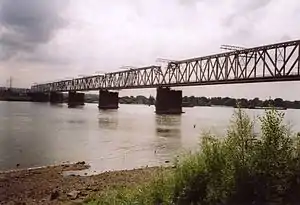Novosibirsk Rail Bridge
The Novosibirsk Rail Bridge is a single-track railway bridge, located at the crossroads of the main branch of Trans-Siberian Railway and the Ob River. It was built in the period between 1893 and 1897 to a design by Nikolai Belelyubsky. The location of the bridge was selected by Nikolai Garin-Mikhailovsky. It is believed that the decision to start the bridge construction near the village of Krivoschekovo (Russian: Кривощёково) was the moment of foundation for the city of Novosibirsk.
The old railway bridge over the Ob | |
|---|---|
 | |
| Coordinates | 55.01°N 82.9180°E |
| Carries | single track (in the period 1984-2000 it was double track) |
| Crosses | Ob River |
| Locale | Novosibirsk, Russian Federation |
| Characteristics | |
| Design | Semi-parabolic trusses, which had a support column and one curved top chord with double-latticework. |
| Material | Steel, reinforced concrete, stone |
| Total length | 983.5 m (3,227 ft) |
| No. of spans | 9х109.25 m (358.4 ft) |
| History | |
| Designer | Nikolai Belelyubsky |
| Opened | 1897 |
| Location | |

| |
Selecting a place to cross the Ob River
The choice of where to construct the future bridge proved to be a major challenge. In accordance with the original draft, the railway line was expected to be laid through the town of Tomsk, which required a bridge across the Ob River about 55 km west of Tomsk, at a place where the Ob river overflowed its banks in spring. It was not proper for construction and required selection of a new location. This work is generally understood to be done by Nikolai Garin-Mikhailovsky (known not only as a railway engineer, but also as a writer). He proposed the only narrow site with rocky outcrops on the surface. The site, about 200 km southwest of Tomsk at what is now Novosibirsk, was just beyond the north end to the Salair Ridge, which might explain the rocks.
At the end of August 1891, a plenary meeting of three major imperial officials took place in the Big Krivoschekovo village. Participants included Head of Department for construction of railways Konstantin Mikhailovsky, State Counsellor Vladimir Berezin (future contractor), as well as Commander of exploration group Vikenti-Ignatsy Royetski. They examined hydrographic data submitted by Royetski on the spot and made the final decision to recommend a line to cross the river Ob on the local cattle wade. That’s how they selected the construction site for the first railway bridge across the Ob River.
Construction and initial design
The design was made by Prof. Nikolai Belelyubsky, an outstanding Russian civil engineer and well-known scientist in the fields of structural mechanics and engineering, who developed the projects for a great variety of bridges in Imperial Russia.
The superstructure system was composed of nine spans equal in length that rested on masonry piers made of local granite.
109-meter (358-ft) long spans consisted of bowstring-arch through trusses with double lattice girders. Due to its high stability, double-lattice design decreased the length of panels and made the bridge's parts easier. The presence of a support column in trusses allowed a simple design of cradles and baseframes, as well facilitated the design of connections between bearing floor beams and trusses. Furthermore, Beleloubski made improvements in the bridge structure by proposing the device of 'free carriageway', which later came to be called "the Russian support method".
Steelwork elements amounting to 4423 tons were manufactured at the famous Votkinsk ironworks in Udmurtia under the supervision of contractor General V.I. Berezin. The height above low water-mark was 17 metres (56 ft).
The bridge was under construction for 4 years, and the expense of its erection was about 2 million rubles.
In 1896, load tests were carried out on the bridge, during which 4 steam engines crossed over it. On 31 March 1897, the bridge was opened for traffic.
All stages of construction were managed by the engineer G.M.Budagov. He remembered with gratitude the time of his cooperation with Nikolai Garin-Mikhailovsky during construction of this railway section, bridge and station. He said: "The activities of our witty, talented person and excellent comrade Nikolai G.Garin-Mikhailovsky made all internal life of the builders and their work some especially colourful and pleasant."
Development and operation

In the 1930s, the old bridge lost its value and started to be used, as a rule, for passenger trains only. This was because the construction of a new double track railroad bridge (dubbed the Komsomolsky bridge) was finished, and a new cargo line around Novosibirsk's center was launched.
In April 1984, the installation of the second main spans was finished. The work train N429 of the West-Siberian Railway erected new spans consisted of 15.7 thousand metal elements amounting to 4.5 thousand tons.
Construction of new spans began in 1974. For this purpose, approaches were made of 78 thousand cubic metres of soil; these were covered by a road leading to the left-bank abutment for ensuring access of metal, concrete and other building materials to the site of work.
To determine the adequacy of the existing piers, a group of experts from Leningrad drilled the piers' bodies and the rocks upon which they had rested. It was considered feasible to install new span structures on the old piers. The Ministry of Railways of the USSR made the decision to erect new spans with subsequent dismantling of the old structures, because their load-carrying capacity didn't meet modern requirements anymore.
A draft of the new bridge was developed by the Moscow Institute of Civil Engineers (Russian: ГИПРОТРАНСПУТЬ). After the commissioning of Novosibirsk hydroelectric power plant, spring ice drifts ended around the city, and so the function of cutwaters (starlings) was no longer relevant.
The bridge builders erected (spliced) seven ferroconcrete supports into the foundations of the former cutwaters and constructed two new abutments. The installation of 100 metres long trusses between the piers was carried out by the balanced cantilever method — from pier to pier — with the use of cranes passing through the top and inside of the trusses.
In 1991, train traffic was halted on the old bridge and its dismantling began in 2000.[1] The new spans were assembled with the use of high-strength bolts, which allowed to quickly install the new spans without scaffolding or any floating means.
The estimated cost of the project was 8 million Russian rubles. The new bridge's spans were stronger and larger, but not as attractive as the old ones, which had well served for almost a century on the great Siberian Railway.
By now, all spans of the old bridge have been removed and the bridge reverted to single track operation. However, the old piers and abutments still exist, that allows the bridge to be widened to double-track, if necessary. Besides, one of the old spans has been kept as a museum piece on the riverside promenade of the city.
References
Sources
- Баландин С.Н. Железнодорожный мост через Обь(недоступная ссылка) // Новосибирск. История градостроительства 1893-1945 гг. - Новосибирск: Западно-сибирское книжное издательство, 1978. - 136 с.
- Баландин С.Н. Новосибирск. История градостроительства 1945-1985 гг. - Новосибирск: Западно-сибирское книжное издательство, 1986. - 160 с.
- Власов Г.М. Первый железнодорожный мост через Обь (Изыскания, проектирование, строительство). - Новосибирск: Изд-во СГУПСа (НИИЖТа). - 36 с.
- Невзгодин И.В. Архитектура Новосибирска. - Новосибирск: СО РАН, 2005. - С. 20-21. - 204 с. - ISBN 5-7692-0736-1.